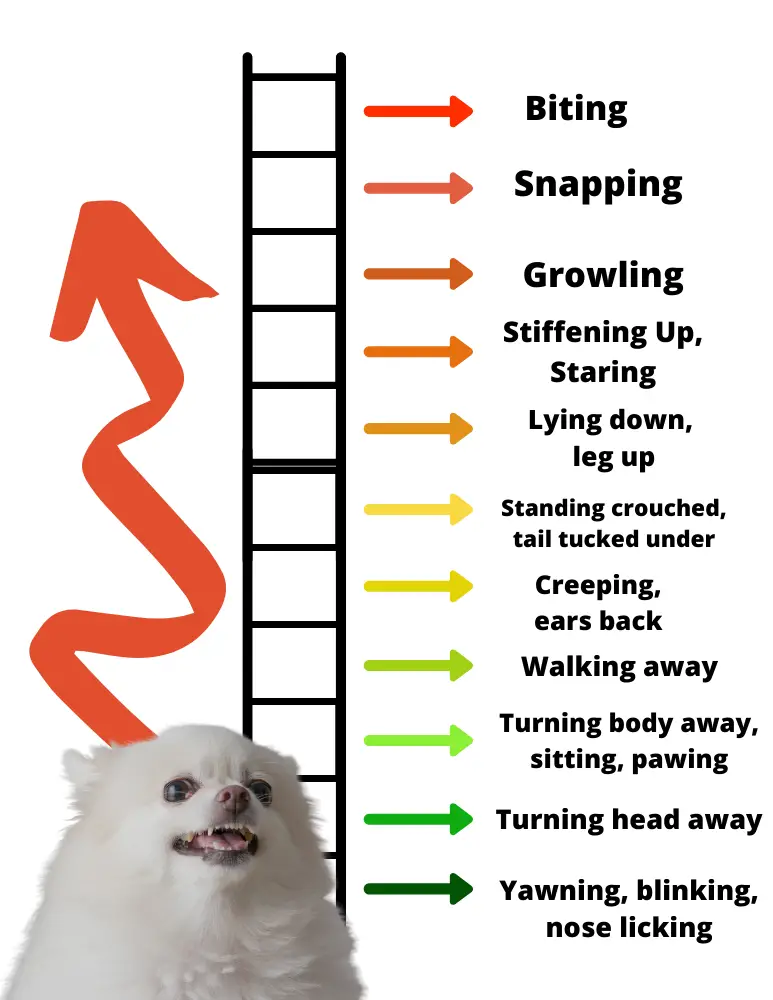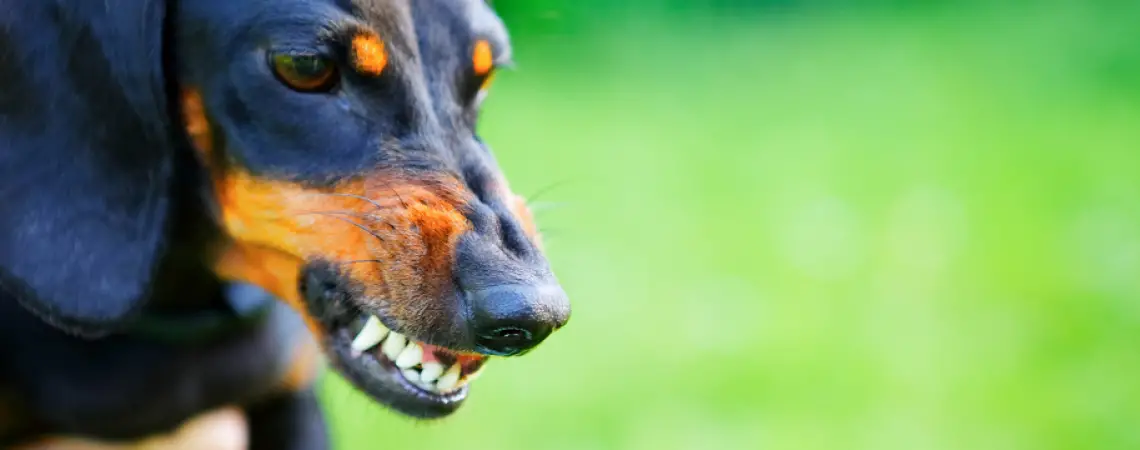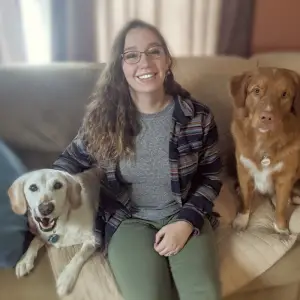It’s an uncomfortable and problematic situation when you find out that your dog is aggressive towards one member of the household. It’s often difficult to know how to manage the situation, as well as how to create positive change and find a solution.
In this article, we will examine what aggression in dogs looks like, why your dog might be aggressive towards one member of the household and not another, and some ways you can work on improving their relationship, and your dog’s behavior.
Aggression in Dogs – What Does it Look Like? What are the signs?
The majority of cases where a dog is displaying aggressive behavior problem (snapping, growling, biting, lunging, etc) are due to the dog feeling afraid.

Aggression is a dog’s way of telling you they are uncomfortable, especially if earlier signs of anxiety have been ignored.
It’s obvious to most people that dogs that are growling, biting, lunging, or snapping are displaying aggression.
However, the earlier signs of anxiety can be thought of as warning signs that potentially lead to a type of aggression, so you can avoid being in a situation where a dog may bite and injury someone.
You can think of anxious and aggressive behaviors as being rungs on a ladder, as depicted in the above graphic. If signs are ignored at the lower rungs, the dog will climb up their ladder and continue to display more and more aggressive behavior until they get their point across.
Learning how to read the more subtle signs of anxiety in dogs will help you prevent your dog from climbing the ladder of aggression.
When reading dog body language, it’s important to take the whole picture and context into consideration. You should take the opportunity to learn more about dog behavior if you really want to understand your dog.
Why is my dog aggressive towards only one member of the household?
It might be a roommate, husband, wife, or child – but sometimes, we find ourselves with a dog that really doesn’t like that one certain person.
The answer that many people jump to is that the dog is being abused by that person. While this can unfortunately be the case, it’s thankfully not a common reason. Before you assume that your dog is being mistreated when you aren’t around, consider some of the other options.
Anxiety or Fear
For some dogs, they don’t handle change well. If you’ve recently acquired a new roommate, or if a significant other has moved in, the change to their living situation can make your dog uncomfortable.
Any time your dog has major changes in their life, their anxiety can be displayed in the form of aggression. Even if your dog previously liked the new person, the extra additions of moving furniture and changing their routine can contribute to their behavior.
This is called trigger stacking, where multiple scary things “add up” and put the dog in a situation where they bite or act aggressively. Just because your dog may be able to handle the usual minor stress of a visitor, or small changes to their home, doesn’t mean they can handle them happening all at once.
Lack of Socialization
In many other cases, their aggressive behavior is simply due to a lack of socialization. If you weren’t able to socialize your puppy well, or if you adopted your dog as an adult, the lack of socialization plays a big role in many of their fearful behaviors.
For example, your dog may have never been socialized to someone who wears a hat. Your family member or roommate might wear hats, or have worn a hat one time, and your dog has now associated them with the scary thing.
No matter the reason your dog is showing aggression towards someone, there are a few things you can do to help make the situation safer for everyone.
This is, of course, not an extensive list, and your dog could be resource guarding, territorial, or even jealous! Understanding dogs takes work, and you’ll need to do some detective work to figure out the root cause before you can proceed. Many things, or even multiple things can cause a dog to become aggressive, even if they weren’t before.
Redirected aggression is even a thing. This is when a dog is afraid of something else but then lashes out at whoever is closest to deal with it, be it another animal or a human bystander.
How to Stop Aggression Towards One Person
If your dog has bitten someone, the aggression is a regular occurrence, and if there is concern for the safety of people in the home, it’s imperative to seek help from a professional trainer. This is true in many cases, even if the dog’s aggression is mild, to prevent an escalation. An aggressive dog can be very dangerous, even a small breed dog can cause serious injury.
An educated professional trainer or veterinary behaviorist, such as those with credentials from the Certification Council of Professional Dog Trainers or International Association of Animal Behavior Consultants, can help your dog by creating a behavior modification plan that’s best for your dog.
Need Help With Your Dog?
Get a behavioral consultation from the comfort of your living room! Fuzzy Pet Health offers convenient video consult services for pet parents starting at $25.
In the meantime, however, there are also several steps you can take to make sure you keep everyone as safe as possible.
If you are able to teach your dog to comfortably wear a muzzle, or use a baby gate or other fencing to separate your dog from the person in question, you can start to work on making your dog feel comfortable.
When your dog and the person they are aggressive towards are in the same proximity, you can help by feeding your dog delicious treats and making sure they feel safe and comfortable. It’s best to avoid having the family members or roommate feed your dog to start, because it can make your dog even more worried to have them that close.
Instead, you can hang out with your dog and be the one to feed your dog food so they learn to associate the person with good things in their life. Along with this counter-conditioning and desensitization, management of a muzzle or other barriers, and working with a professional, you’ll be able to create a plan to safely solve your dog’s aggression problems.
Just remember that training takes time. There are no instant solutions, and you’ll need to be patient with your dog. Understand that they are likely acting out of fear and not really hatred of the person in question.





